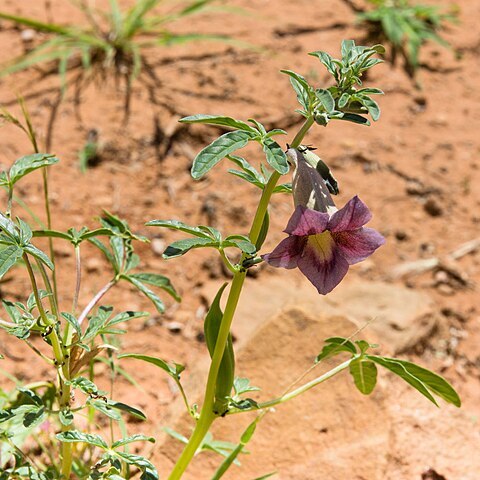Annual or perennial herb, 0.15-2.00 m high; younger parts densely glandular-pilose. Leaves: lamina of lower leaves 5-7-fid, upper ones 3-fid; upper surface ± glabrous, venation sunken, lower surface glandular-pilose, venation winged. Flowers with extrafloral nectaries (reduced flowers) at base; usually purple, throat dark purple. Calyx much shorter than corolla tube. Corolla: tube shortly cylindrical at base, obliquely campanulate above; limb subbilabiate. Stamens subdidynamous, included. Ovary subcylindrical, 2-locular, falsely 4-locular with false, parietal septum; ovules many per compartment, 1-rowed; placentation axile; style included; stigma of 2 ± obovate, membranous lobes. Fruit a ± erect capsule, narrowly oblong, shortly beaked, 4-sulcate, loculicidal towards base. Seeds obovate, 3-winged with 1 apical and 2 lateral wings.
Glabrous annual, up to 1 m tall, with mucilage glands at nodes. Leaves polymorphic, with the lower ones 3-7-foliolate or-partite with obovate-oblong to linear leaflets, upper ones ± mealy glandular. Flowers 1 per leaf axil, ± broadly trumpet-shaped, purple-violet. Fruit woody, ± cylindrical, with short apical beak and basal knobs. Flowering after rain.
Annual herb, up to 1.5 m high. Leaves with blade mostly 5-7-lobed in lower part, upper ones 3-lobed, terminal leaflet up to 70 mm long. Flowers: solitary, axillary, shortly pedicellate; corolla 25-45 mm long; purple with dark purple throat; Dec.-Apr. Fruit a capsule, erect, ± 30 mm long, glabrous. Seeds with wings all round or on 3 sides.
A shrub. It is an annual plant with a taproot. It grows 2 m tall. The stems have 4 angles. The lowest leaves have 5-7 lobes. The higher leaves have 3 lobes. The flowers are large and have a tube 2-4 cm long. They occur singly in the axils of leaves. The flowers are purple. The seeds are small and light brown and have wings.
Herb, up to 1.5 m high. Lower leaves mostly 5-to 7-, upper mostly 3-lobed. Corolla 25-45 mm iong. Seeds with wings all round or on 3 sides. Flowers purple with dark purple throat.
Erect, subglabrous, glandular annual to 1.5 m. Leaves mostly 3-7-digitate, leaflets narrowly elliptical. Flowers pink to mauve. Fruits erect, cylindrical, beaked; seeds 3-winged.

